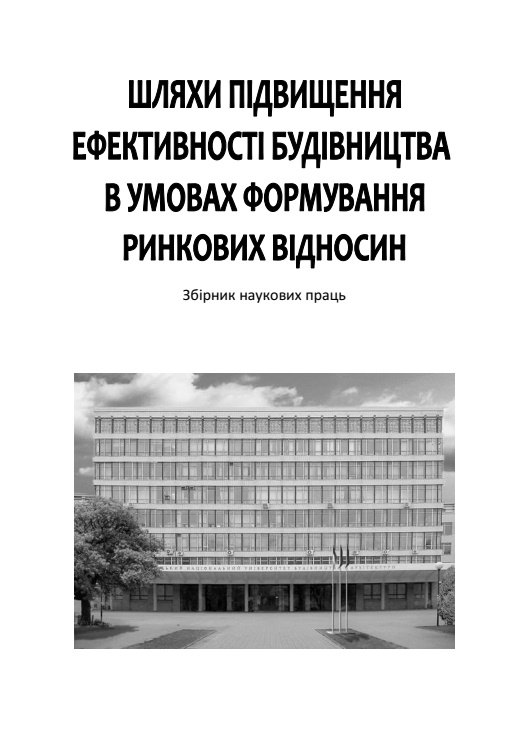System geometric interpretation
DOI:
https://doi.org/10.32347/2707-501x.2019.39.190-197Keywords:
system-geometric modeling, adaptability, energy efficiency, architectural and construction cluster.Abstract
The article describes one of the stages of developing effective methods for analyzing the set of possible development scenarios and forecasting the effectiveness of the functioning of clusters. The purpose of this article is to search for approaches and concepts to objectivize and identify the main structural system elements of an energy-efficient architectural and construction cluster with adaptive properties. A “cluster” model can be viewed as a collapsible-structured model with geometric components, a geometric design or a geometric representation of an element model can describe the representations of a set of geometric and graphical methods. The main ways to objectify the system of key indicators are defined. Due to the fact that the internal structure of an adaptive energy-efficient architectural and construction cluster contains a significant number of structural elements, their analysis and coordination require separate consideration in subsequent publications.References
Закон України «Про енергозбереження» / Відомості Верховної Ради України (ВВР), 1994, N 30, ст.283 – Редакція від 23.07.2017. – Режим доступу: https://zakon.rada.gov.ua/laws/main/74/94-вр
Закон України «Про енергетичну ефективність будівель» / Відомості Верховної Ради (ВВР), 2017, № 33, ст.359. – Прийняття від 22.06.2017. – Режим доступу: https://zakon.rada.gov.ua/laws/show/2118-19
Стратегія сталого розвитку "Україна - 2020" / Указ Президента України від 12 січня 2015 року № 5/2015. – Режим доступу: https://zakon.rada.gov.ua/laws/show/5/2015#n10
Микитась М. В. Сталий розвиток міст: стан досліджень, міжнародний та український досвід / М. В. Микитась, В. О. Плоский // Енергоефективність в будівництві та архітектурі, – 2017. – Вип. 9. – С. 168-173.
Микитась М. В. Дослідження системних ознак енергоефективних кластерних організаційних структур архітектурно-будівельної галузі / М. В. Микитась, В. О. Плоский, С. А. Кожедуб // Управління розвитком складних систем. – 2018. – № 35. – С. 68-75.
Kulikov P. Development of a methodology for creating adaptive energy efficiency clusters of the architecture and construction industry / P. Kulikov, M. Mykytas, S. Terenchuk, Yu. Chupryna // Technology audit and production reserves – № 6/5(44), 2018, page 11–16. DOI: 10.15587/2312-8372.2018.150879.
Плоский В.О., Бондар О.А. Щодо проблеми системного опису соціально-технічної організаційної структури // Шляхи підвищення ефективності в будівництві в умовах ринкових відносин. - К: КНУБА. 2005. – Вип. 14. – С. 155-162.
Плоский В. А. Операции на множестве методов геометрического моделирования как элемент их системного исследования / В. А. Плоский // Прикладная геометрия и инженерная графика. – 1996. – Вып. 60. – С. 79 - 83.
Карпов Л.Е. Адаптивное управление по прецедентам, основанное на классификации состояний управляемых объектов / Л.Е. Карпов, В.Н. Юдин // Труды Института системного программирования РАН. – 2007. – Том 13. – Часть 2. – С. 37-55.
Попов В. М. Методологія адаптивного управління програмами розвитку територіальних систем техногенної безпеки в динамічному оточенні / В. М. Попов // Автореф. дис. … д-ра техн. наук за спец. 05.13.22 – управління проектами та програмами. – К.: КНУБА, 2015. – 40 с.
Клир Дж. Системология. Автоматизация решения системных задач / Дж. Клир. – М.: Радио и связь, 1990. – 534 с.
Плоский В.О. Принципи визначення загальносистемних властивостей методів геометричного моделювання// Прикл. геометрія та інж. графіка. – К.: КНУБА, 2008. – Вип. 79. – С. 23-27.
Downloads
How to Cite
Issue
Section
License

This work is licensed under a Creative Commons Attribution 4.0 International License.
Authors who publish with this journal agree to the following terms:
- Authors retain copyright and grant the journal right of first publication with the work simultaneously licensed under a Creative Commons Attribution License that allows others to share the work with an acknowledgement of the work's authorship and initial publication in this journal.
- Authors are able to enter into separate, additional contractual arrangements for the non-exclusive distribution of the journal's published version of the work (e.g., post it to an institutional repository or publish it in a book), with an acknowledgement of its initial publication in this journal.
- Authors are permitted and encouraged to post their work online (e.g., in institutional repositories or on their website) prior to and during the submission process, as it can lead to productive exchanges, as well as earlier and greater citation of published work (See The Effect of Open Access).

